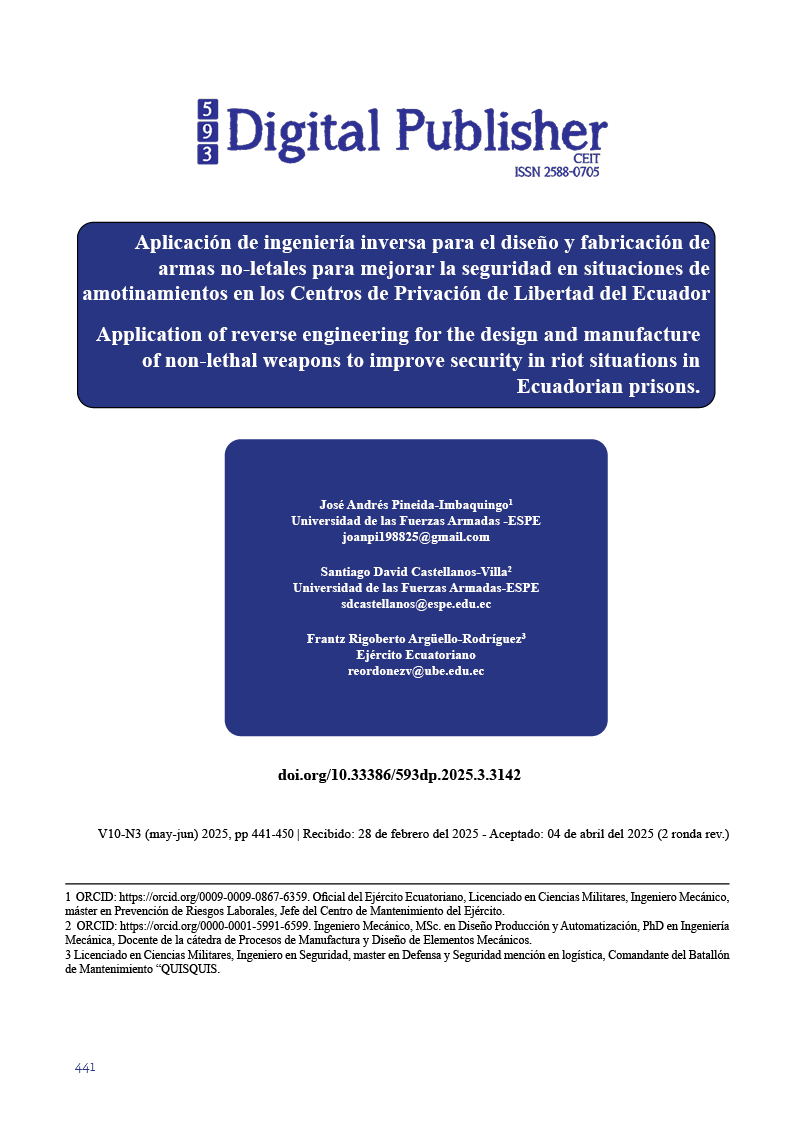Application of reverse engineering for the design and manufacture of non-lethal weapons to improve security in riot situations in Ecuadorian prisons.
Main Article Content
Abstract
The Department of Energy and Mechanical Sciences of the University of the Armed Forces (ESPE), together with the "Quiquis" Maintenance Battalion, a unit of the Ecuadorian Army, developed a reverse engineering project for several non-lethal kinetic launchers currently in use in the country. This project will be used to design and manufacture non-lethal weapons for use in riots in prisons. In the first stage of the project, led by Engineer Sebastián Olivo, a research project yielded results on stresses, deformations, safety factors, analysis of the propulsion mechanisms, and exploded views of the non-lethal weapon. In this second stage, the non-lethal weapon and its accessories were manufactured using the nationally available technological support, such as CNC machines, a high-speed precision lathe Model S430 x 1000G, and 3D printers. Likewise, the materials used for its manufacture are available over-the-counter and were: 7075-T6 aluminum alloy for machining the body of the non-lethal weapon. This material allows the parts to withstand high fatigue due to its hardness and high density. The manufacturing time of the non-lethal weapon was approximately 168 hours. Subsequently, firing tests were conducted with talc projectiles, thus validating the functionality of this work.
Downloads
Article Details

This work is licensed under a Creative Commons Attribution-NonCommercial-ShareAlike 4.0 International License.
1. Derechos de autor
Las obras que se publican en 593 Digital Publisher CEIT están sujetas a los siguientes términos:
1.1. 593 Digital Publisher CEIT, conserva los derechos patrimoniales (copyright) de las obras publicadas, favorece y permite la reutilización de las mismas bajo la licencia Licencia Creative Commons 4.0 de Reconocimiento-NoComercial-CompartirIgual 4.0, por lo cual se pueden copiar, usar, difundir, transmitir y exponer públicamente, siempre que:
1.1.a. Se cite la autoría y fuente original de su publicación (revista, editorial, URL).
1.1.b. No se usen para fines comerciales u onerosos.
1.1.c. Se mencione la existencia y especificaciones de esta licencia de uso.
References
Agencias de El Comercio. (2021, Febrero 23). Autoridades confirman 62 asesinatos en tres cárceles tras amotinamientos de este 23 de febrero | El Comercio. https://www.elcomercio.com/actualidad/seguridad/muertos-heridos-amotinamiento-carceles-ecuador.html
Ecrimesagroup. (2023). Como usar la técnica MIM de moldeado de metales. Https://Ecrimesagroup.Com/Es/Como-Usar-La-Tecnica-Mim-de-Moldeado-de-Metales/.
Gibson, I., Rosen, D., & Stucker, B. (2015). Additive Manufacturing Techbologies (Springer, Ed.; Second Edition).
Groover, M. p. (2007). Fundamentos de manufactura moderna (M. E. S. A. Hill, Ed.; Tercera edición).
High Pressure Technologies. (2023). Moldeado por inyección de metal (MIM). Https://Www.Hiperbaric.Com/Es/Tecnologia-Hip/Tecnicas-de-Fabricacion-Hip/Moldeado-Por-Inyeccion-de-Metal/.
National Shooting Sports Foundation. (2020). Informe de la NSSF sobre el impacto económico de la industria de las armas de fuego y las municiones en 2020. Https://Www.Nssf.Org/Wp-Content/Uploads/2020/04/2020-Economic-Impact.Pdf.
Olivo, S. (2022). Diseño y simulación de un prototipo de arma no-letal de impacto por energía cinética para munición con agentes RCAs con capacidad para adaptarse a un vehículo táctico milita [Universidad de las Fuerzas Armadas ESPE]. http://repositorio.espe.edu.ec/handle/21000/28150
Pepperball. (2021a). Hoja de especificaciones de TAC-SF. https://www.pepperball.com/wp-content/uploads/2018/12/spec_TAC-SF.pdf
Pepperball. (2021b). Productos - Pepperball. https://www.pepperball.com/products/
Pepperball. (2021c). Projectiles Archives - Pepperball. https://www.pepperball.com/product_cat/projectiles/ g
Pepperball. (2021d). VKS TM User Manual VARIABLE KINETIC SYSTEM. www.pepperball.com
Pepperball. (2021e). VKSTM Magazine. https://www.pepperball.com/products/vks-magazine/
Pineida, A. (2023). Desarrollo de sistemas de armas antidisturbios para uso en incidentes de desorden público [Universidad de las Fuerzas Armadas ESPE]. http://repositorio.espe.edu.ec/handle/21000/36069
Puente, D. (2020, January 5). USD 3,6 millones invertidos para armamento no letal para la Fuerza Terrestre en Ecuador. Https://Www.Elcomercio.Com/Actualidad/Inversion-Armamento-Fuerza-Terrestre-Ecuador.Html.
Primicias (2022, Noviembre 18). Once masacres carcelarias y 413 presos asesinados en 21 meses. https://www.primicias.ec/noticias/en-exclusiva/carceles-nueve-masacres-victimas-ecuador/
Ramos, D. (2013). USO DE LA INGENIERÍA INVERSA COMO METODOLOGÍA DE ENSEÑANZA EN LA FORMACIÓN PARA LA INNOVACIÓN. Https://Acofipapers.Org/Index.Php/Eiei/Article/View/1541/1545.
Tippmann. (2013). CRONUS Paintball Marker Owner’s Manual. http://paintball.tippmannparts.com/diagrams/Tippmann Cronus Manual.pdf
Tippmann. (2016). Tippmann M4 Carbine .68 Caliber. https://gidirect.com/wp-content/uploads/2019/09/TP04405TippmannM4Carbine68calOwnersManual0716.pdf
Tippmann. (2020). Tippmann Paintball. https://tippmann.com/
Tippmann. (2021). 98 Custom Platinum Series Marker. https://www.academia.edu/11333789/98_Custom_Platinum_Series_Marker_TIPPMANN_98_Custom_Platinum_Series_at_BULLET_with_ACT_at_BULLET_Non_ACT
Tippmann Parts. (2018). Tippmann Cyclone Feed System. https://www.tippmannparts.com/Tippmann-Cyclone-Feed-System-98-Alpha-Black-p/8304.htm
Ulrich, K. T., & Eppinger, S. D. (2013a). Diseño y desarrollo de productos (S. A. D. C. V. McGRAW-HILL/INTERAMERICANA EDITORES, Ed.; Quinta).
-7075- (ALUMINIO – ZINC). (n.d.). Retrieved November 9, 2022, from https://studylib.es/doc/4907872/-7075---aluminio-%E2%80%93-zinc-




